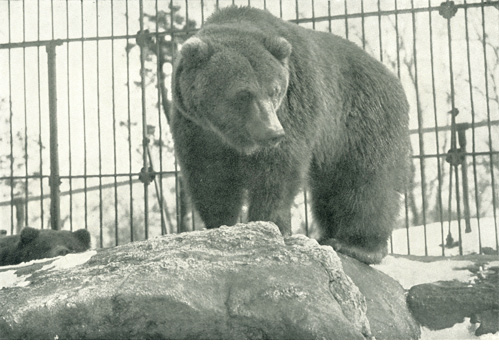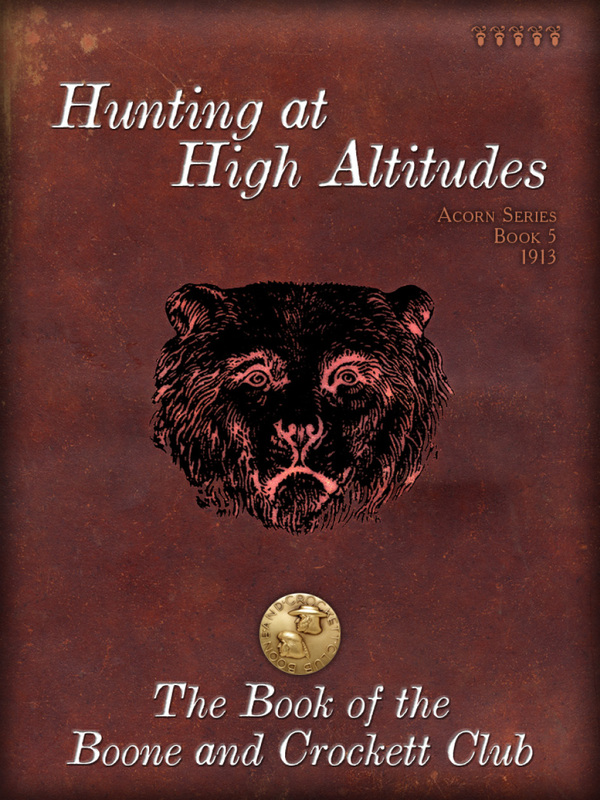The opening of the twentieth century found the game in the old territories of the United States well on the road toward the conditions that precede extinction. The bison had been practically gone for two decades. The mountain sheep had been exterminated throughout a very large part of its original range, and the number remaining in remote mountains was sadly reduced. The wapiti, while still living in herds numbering many thousand, was rapidly withdrawing to the vicinity of its last refuge, the Yellowstone Park. The pronghorn of the plains was disappearing with increasing rapidity, partly because of the increasing use of the barb-wire fences on its former ranges.
This rapid diminution of the game animals of the United States was the inevitable consequence of the settlement and occupation of the best grazing lands. While there remain mountains where the game is relatively undisturbed, so far as the killing of individuals is concerned, and while these ranges in summer appear well adapted to sustain a large and varied fauna, their actual capacity to sustain life is limited to such animals as can there find sustenance during the heavy snows of winter.
Before the arrival of white men, the animals, which lived in the mountains during the summer, during the cold season sought refuge in the sheltered valleys and foothills. These favored localities, however, were at once occupied by settlers, and the game was deprived of its winter feeding grounds. This has done more in recent years to exterminate the large animals of the West than the actual shooting of individuals.
During the closing years of the nineteenth century the American people had obtained no little experience in game protection, and had embodied it in Federal statutes and the game laws of the various States. Of all the regulations established for the preservation of wild life, the most practical and effective have been found to be, first, the prohibition of hide and head hunting; second, the prohibition of market hunting; third, and most important of all, the establishment of sanctuaries where game can roam and breed absolutely undisturbed. The most conspicuous example of such refuges is the Yellowstone Park, the success of which is admitted on all sides.
At the end of the century, the gold discovered in the extreme northwest of Canada and in Alaska brought these territories suddenly before the public eye. Here was a district of enormous extent, lying at the extreme limit of the continent, and populated by a large and varied fauna, which was practically undisturbed. During the last ten years, thousands of prospectors and miners have gone into Alaska, and in many places worked havoc with the game. On the whole, however, the destruction of the game has not yet gone far enough to permanently injure the fauna of the region, provided the matter of protection is taken in hand scientifically and in the immediate future.

The general principles of game protection, applicable to the situation in Alaska, are simple. It should be clearly understood that the game of Alaska, or of any other region, does not belong exclusively to the human inhabitants of that particular region, and that neither the white settlers nor the native inhabitants have any inherent right to the game, other than that conferred by law. The interest of the entire people of the United States, and to some extent that of the civilized world, is centered in the continued existence of the forms of animal life which have come down to us from an immense antiquity through the slow process of evolution. It is no longer generally conceded that the local inhabitants of any given district have a divine commission to pollute streams with sawdust, to destroy forests by ax or fire, or to slaughter every living thing within reach of rifle, trap or poisoned bait. This must be thoroughly understood in advance. The game and the forests belong to the nation, and not to the individual, and the use of them by the individual citizen is limited to such privileges as may be accorded him by law. The mere fact that he has the power to destroy without interference by the law, does not in itself confer a right. The destruction of game is far more often effected by local residents than it is by visiting sportsmen, but the chief evildoer, and the public enemy of all classes, is the professional hunter, either Indian or white, who kills for the market. Worse still, perhaps, is the professional dealer in heads and antlers, who employs such hunters to provide game heads for the decoration of the banquet halls of the growing class of would-be sportsmen, who enjoy the suggestion of hunting prowess conferred by a selected collection of purchased heads, mixed in with those of their own killing.
However efficient the game law may be in limiting the killing to a given number of individuals, and to certain seasons of the year, or, better still, to the adult males of certain species, the only permanently effective way to continue in abundance and in individual vigor any species of game is, to establish proper sanctuaries, as thoroughly controlled as the Yellowstone Park, and these must contain both summer and winter ranges. In such areas no hunting or trapping—perhaps even no dogs—should be allowed; and in them the game will then retain its native habits and breed freely, while the overflow will populate the adjoining districts. This principle has been applied with brilliant success in East Africa, where a protected strip of land on either side of the Uganda Railway is now absolutely swarming with game.
From the point of view of game conditions, Alaska is divided into two entirely distinct regions. First, the Coast Region, from Portland Canal along the base of the mountains northward, and then westward, to and including the Aleutian Islands.
The second region comprises the interior beyond the mountains, and is co-extensive with the region drained by the Yukon and its various branches.
In these two regions conditions differ widely, and practically all the sportsmen who go to Alaska hunt in the coast region. Those who cross into the interior are likely to confine their shooting to the headwaters of the Yukon in Canadian territory.
The game on the coast between Portland Canal and Mt. St. Elias consists principally of bear and the small Sitka deer. On the mainland, close enough to salt water to be easily reached, white goats are abundant. To reach moose, caribou or sheep from the southeastern coast, requires a journey over the mountains into British Columbia, which is seldom attempted, except from Fort Wrangell at the mouth of the Stikeen River.
West of the St. Elias Alps and around Cook Inlet, the principal game animals are the giant moose and white sheep of the Kenai Peninsula, the caribou and bear of the Alaska Peninsula, and the bear of some of the large islands, notably Kodiak. It is in this district that the game laws require close attention and rigid enforcement. In the vast interior the strict enforcement of game laws is not so important, because the entire region drained by the Yukon is covered with heavy forests, and the population is largely confined to waterways.
Black bear, lynx and moose are everywhere abundant, but seldom seen along the Yukon River. Sheep are accessible from points on the Upper Yukon, notably at Eagle, and caribou occasionally cross the river in herds at that point.
The game laws for this district should aim principally at the prevention of slaughter on a large scale for market purposes, and of hide and head hunting. There are very few sportsmen, and the miners and prospectors in the interior are difficult to control.

www.historyofhunting.com/acorn-series-ebooks
www.boone-crockett.org

